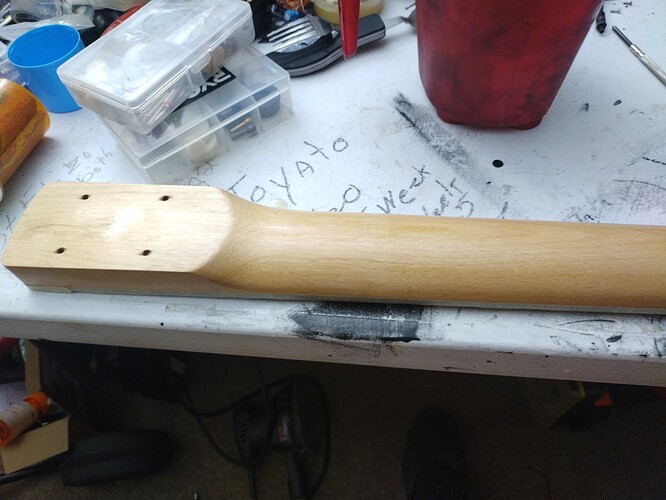I have never actually thought of becoming an apprentice for a Luthier. I even know a couple luthiers personally. I have to redo the tuners on my Glarry acoustic bass. Because, I don’t like the sealed gear single mounting screw tuning keys. Well I bought a Glarry fretless bass from Temu. For a few bucks cheaper than my acoustic bass. Was hoping that I didn’t have to do anything to it. Besides rewire the bass. But, I didn’t get that lucky. Not only was the fret fretboard drier than the desert. But, the rest of the neck wasn’t finished. If I $100 or more for these things. I would have been bitching about it. But, it ain’t nothing to sand the neck really smooth, and apply at least three coats of polyurethane.
I just made a bass fretless. But for now I’ll stick with an oiled wooden fretboard.
Why the choice for polyurethane?
The polyurethane is not for the fret fretboard. I’ve got some lemon oil for that. The polyurethane is the rest of the neck. Also polyurethane is the only thing I’ve got. Besides the dark Ebony stain. I may push the issue with guitar and bass building. But, I would never apply polyurethane to get the fretboard!![]()
![]()
Ah, cool! I was worried ![]()
Hey I truly understand and truly appreciate that man. But I ain’t going to mess up this phone fretboard. I bought a Glarry acoustic bass last month, and over the weekend. I bought a Glarry fretless bass from Temu for the both. Both basses needed the fret fretboard oiled badly. They both were drier than the desert. Anyway, the neck on my fretless wasn’t finished. If it did have a finish on it. They done a crappy job with the finish. It wasn’t smooth, but rough all over the neck. So I’m really close to start to apply the first coat of polyurethane. I’m actually thinking about applying ebony stain first. I’m not sure if it will match up with the sunburst body.
If you sand it, I would advise to use a radius sanding block that matches your neck:
If I had a radius any block dimension neck I most definitely would, but I don’t. I’m holding into my hand and let my hand all wrap around the neck and I’m starting with like 180 or so just to remove some bad spots. But, as far as the finishing work. I’ll start with 100 or 1000 I mean. Working my way up to 1500. Then finally finished sanding with 3,000 grit. For that smooth as a baby’s ass feel. Then I’ll start with the fun part.
They are cheap, easy to get and in my opinion ABSOLUTELY NECESSARY for fretless!
https://www.amazon.com/sanding-fingerboard-leveling-9-5inch-20-Luthier/dp/B08RCPCQ6H
Reason: every unevenness on the fretboard will have side effects, be it buzzing, dead notes etc.
I had to wait for more than a week for that stupid radius sanding block, but I am happy that I waited, as it so much more precise!
I’ll definitely invest in them. This is f****** G Larry b******* Bass. Ain’t no way in hell I would have paid more than what I paid for it. Now with as much as I got to do to this bass. Well I just got the first coat of pre-stain on there. Bout ready to wipe it off. Then debate if I want to go with the ebony stain or just straight polyurethane.
I think he’s talking about sanding the back of the neck not the fretboard. I might be wrong though.
Ah, ok!
@Bubbas5thbassguitars - then: sand away!!! ![]()
I’m done with sanding. Got the free stain down wiped it off. It said to apply stain within two hours. I’m on play the ebony stain I have. Wipe it down then go over with the poly this afternoon or tomorrow. I’m after I apply one coat of ebony stain. I’m going to bed after I clean my brushes
I paid 30€ in town and the tech called me to tell me he would try to save my strings, but he has to flip them over (as I wound them the wrong way) and it’s risky. Best store in town, City Music Bonn. ![]()
Please elaborate on that ![]()
Well, if the headstock has a treble and a bass side (2+2), the strings should go to the inside of the tuner posts. If you have a Fender style bass, they should go to the treble side (down).
I wound the treble strings from the outside. Somehow that’s less good, maybe for tuning stability, I don’t know.
Hahahaha - yes! happened to me after a short night and lack of patience when assembling my bass ![]()
I think most of us have accidentally done this before ![]()
Nah! It’s the same but your tuning is reversed that’s all.
Well, maybe your nut has higher potential to break sooner than the traditional wound because of the extra force from string angle from tuners to the nut.
It’s not the same for your ego. Having done that too, it was a reminder of my lack of focus and abundance of stupidity ![]()









